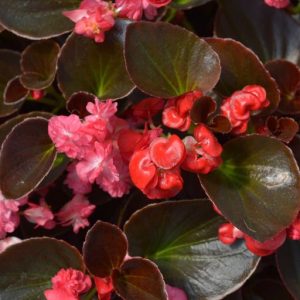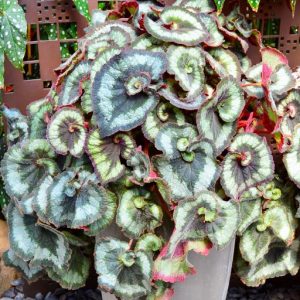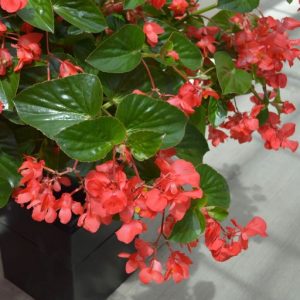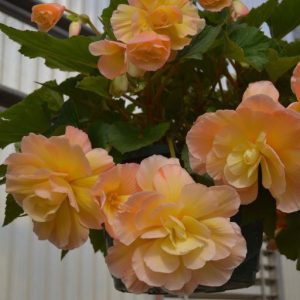
Wax begonias are available in a range of flower and leaf colours as well as single and double flower forms. (Photo: Helen Battersby)
Originating in the tropics, begonias (family Begoniaceae) are among the largest and most diversified genus of indoor plants, with over one thousand species and thousands of hybrids varying from miniature terrarium-sized plants to giants over six feet in height.
Begonias are characterized by ornamental, more or less succulent foliage with alternate, usually lopsided leaves. The flowers are borne in clusters with each flower being either male or female, both of which appear on the same plant. Among begonias, there are many variations in leaf size, shape and colour, growth habit and inflorescence. There are different approaches to classifying begonias into groups. One common way of doing so is according to the types of roots – fibrous, rhizomatous and tuberous. Even though there are so many ways to classify begonias, most thrive under similar conditions.
The fibrous root and rhizomatous begonias, which are prized as houseplants, are discussed below, separately from tuberous begonias, which are usually grown outdoors as tender perennials and go dormant in the winter.
Fibrous root begonias
Wax, cane-stem and hairy-leaf begonia are among the best known of the fibrous root begonias. The wax begonia, or everblooming semperflorens begonia (B.Semperflorens Cultorum Group) is named for its waxy, shiny leaves. It is a compact plant, with erect stems and numerous small flowers, often used as a summer bedding plant.
Cane begonias (B. coccinea) have tough stems and are sometimes known as ‘angel wing’ begonias because of their leaf shape. Hairy-leaved begonias have a coat of velvety or bristly hairs on their leaves and outside the flower petals.

Its unusual snail-shaped leaf gives Begonia ‘Escargot’ its name; just one of many dramatic Rex Begonias. (Photo: Helen Battersby)
Rhizomatous begonias
These begonias grow from horizontal stems called rhizomes that creep just above the soil, sending out shallow roots. They are prized more for their spectacular foliage than their flowers. For example, B. masoniana, the “Iron Cross” begonia, is well-known and named because of the markings on its leaves. Rex begonias (Rex Cultorum Group) begonias are hybrids that exhibit a variety of leaves in many colours – streaked, spotted, splotched.
Care of begonias
Keep flowering begonias in a bright area with some direct sunlight – early morning sun, e.g., in an east window. Begonias grown mainly for their showy leaves grow best in a bright spot away from direct sunlight. All begonias like warmth and humidity, but water only when the soil surface feels dry; too much moisture will cause the roots to rot. As the rhizomes of rhizomatous begonias store water, these plants can tolerate neglect better than other types of begonias. Do not mist the leaves of any begonia, as this encourages powdery mildew. Fertilize with a balanced liquid fertilizer diluted to half-strength during growth periods. Pinch the tips of the plants to encourage compact, bushy growth.
During the winter, some varieties of rex begonias may enter an almost dormant period, where they lose most of their leaves; if this occurs, water them less often and allow the soil to dry out more – once the plant starts to wake up, resume normal watering. During the winter dormant period, fertilizer and water should be applied sparingly, or not at all. Wide, shallow pots are best for rhizomatous begonias, as their stems grow on or near the surface. Wax begonias thrive when they are pot-bound, so seldom need repotting.
Pests and Diseases
Many of the pests (e.g., mealy bugs, whiteflies and spider mites) and diseases (e.g., bacterial leaf spot, botrytis blight, fungal rot) that can affect begonias, are not unique to these plants. These are discussed more fully in the link, Problems Common to Many Indoor Plants, at the end of this guide, under References.

With their pendant flowers, Angel Wing begonias make long-blooming choices for containers. (Photo: Helen Battersby)
Propagating fibrous root and rhizomatous root begonias by cuttings
These begonias can be propagated from seed (very challenging!) or by plant or rhizome division. They can also be propagated via stem or leaf cuttings. Do a bit of research before selecting a method, as some may work particularly well for particular varieties – e.g., angel wing and hairy-leaved begonias are best propagated by stem cuttings. The best time to take cuttings is in the spring, when plant growth is starting to become more vigorous.
- Cuttings
- Stem cutting: Cut an 8-10 cm (3-4 inch) section of stem just below a node and remove leaves from the bottom part of the stem.
- Rhizome cutting: Cut an 8-10 cm (3-4 inch) section of rhizome
- Leaf cutting: Cut a healthy, mature leaf from the begonia, where the leaf and stem meet. Trim the cut end to a point.
- Leaf sections: Cut a healthy leaf into pieces, with each piece containing a small length of midrib or vein
- Plant directly into a moist soilless potting mix (these mixes usually consist of peat moss, perlite, vermiculite and/or coarse sand). Make a small hole in the potting medium with a pencil and insert the stem or leaf stem, cut end down. Gently tamp down the potting medium so that the cutting stands upright. For a rhizome cutting, just press the rhizome flat (horizontally) onto the growing mix. If you are using a leaf, bury only the leaf stem, not the leaf itself. If you are using leaf sections, press each section into moist growing mix.
- If you wish, just before planting, dip the cut end of stem in a rooting hormone. This is optional, and can help the cuttings sprout.
- Cover the pot with a clear plastic bag, and keep at a warm temperature. Keep the potting mix kept moist. A new plant should emerge in 1-2 months.
Tuberous begonias
These bushy, well-branched begonias grow from tubers and have many large, rounded leaves. They are grown for their flowers, which can range from single to double and come in all colours except blue. Flowers may be tiny or the size of dinner plates. Many varieties of tuberous begonias are grown outdoors as tender perennials, then brought indoors to over-winter as houseplants, or the tubers dug up and stored. They can also be grown as houseplants year-round.
Most tuberous begonias flower during the summer. A couple of varieties bloom in early winter and are kept indoors: Lorraine or Christmas begonia (B. Cheimantha Group) and Hiemalis Begonia (B. Hiemalis Group). These are usually discarded after they flower, but can be cut back and put in a cool place – new shoots may emerge, and can be rooted.
To bring in tubers growing in the garden, dig them up in the fall after the foliage has started to yellow and before the first hard frost – leave the root ball and soil intact and store in a cool, dry area (basement or garage are ideal) to cure the tubers for a few weeks. Next, remove the stalks and roots and shake off the soil, then pack the tubers in dry peat, sawdust or sand and store in a cool, dry, dark spot where the temperature does not dip below freezing. Bring them out of hibernation in the spring and place them in a warm spot, in damp peat moss. Once roots and stalks start to grow in March or April, pot them up in rich potting soil and start watering them. Bring the plants outdoors once all danger of frost has passed.
Begonia grandis is a tuberous begonia that can overwinter in the garden in zones 6 -8 with added mulch in slightly cooler areas. It is slow to break dormancy, grows 45 to 60 cm tall, with pink flowers in the fall and stunning red veins on the underside of the leaves.
References
American Begonia Society. www.begonias.org
Relf, D. Virginia Cooperative Extension. Propagation by Cuttings, Layering and Division. https://pubs.ext.vt.edu/content/dam/pubs_ext_vt_edu/426/426-002/426-002_pdf.pdf
Missouri Botanical Garden. Problems common to many indoor plants. https://www.missouribotanicalgarden.org/gardens-gardening/your-garden/help-for-the-home-gardener/advice-tips-resources/visual-guides/problems-common-to-many-indoor-plants.aspx
Chadwick P.Begoniaceae – A Genus Worth Exploring. January 2016. Piedmont master gardeners/ Virginia cooperative extension master gardeners. https://piedmontmastergardeners.org/article/begoniaceae-a-genus-worth-exploring/
Date Revised: June, 2021
Prepared by the Toronto Master Gardeners, these Gardening Guides provide introductory information on a variety of gardening topics. Toronto Master Gardeners are part of a large, international volunteer community committed to providing the public with horticultural information, education and inspiration. Our goal is to help Toronto residents use safe, effective, proven and sustainable horticultural practices to create gardens, landscapes and communities that are both vibrant and healthy.
Statement on Invasive Plants: When choosing plants, avoid invasive plants, which can spread quickly and dominate gardens. Invasive plants are sold by nurseries, big box stores or even at community plant sales. Invasives may already be present in your garden. They can invade gardens by spreading from under a neighbour’s fence or may be transported by wildlife. For beautiful, sustainable options to invasive plants, see the Ontario Invasive Plant Council’s “Grow Me Instead – Beautiful Non-Invasive Plants for your Garden” at https://www.ontarioinvasiveplants.ca/resources/grow-me-instead/before purchasing or accepting “gifts” of plants.
Statement on Home Remedies: The Toronto Master Gardeners do not recommend home remedies, as these have not been proven effective through scientific investigation, and may even damage other living organisms in the soil or plants in your garden. There are other garden friendly options you can use.
If you have further gardening questions, reach us at our gardening advice line 416 397 1345 or by posting your question here in the Ask a Master Gardener section. To book Toronto Master Gardener volunteers for talks, demonstrations, advice clinics, or other services, please contact us at 416 397 1345 or bookamg@torontomastergardeners.ca


